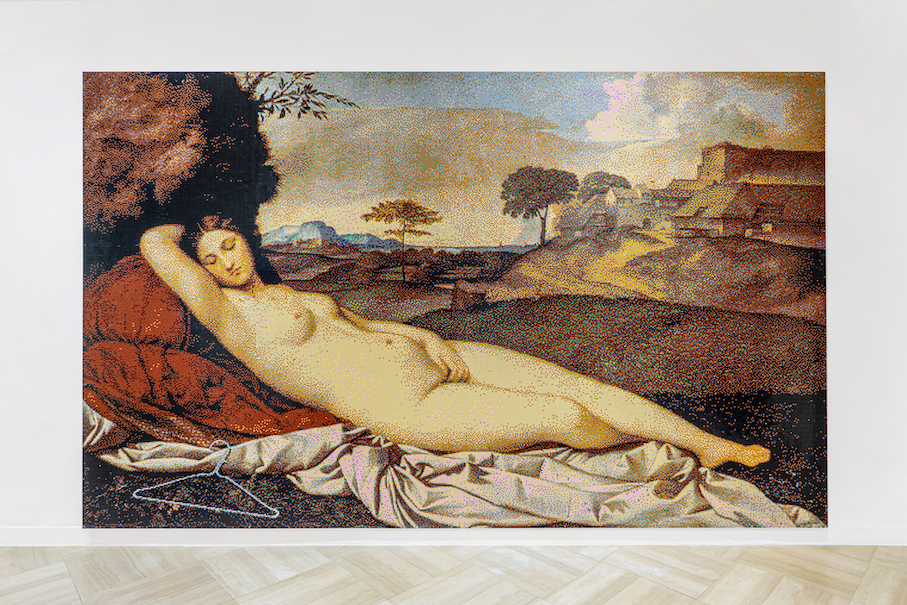The 20th Biennale of Sydney “The Future is Already Here—It’s Just Not Evenly Distributed” kicked off on March 18. Artistic Director Stephanie Rosenthal organized the theme of this year’s biennale around seven “Embassies of Thought,” as well as various “in-between spaces” inspired by the histories of each location. During her introduction, Rosenthal explained that “the embassies of thought aren’t so much related to the term ‘embassy’ that we are familiar with; they are about coming together to have a safe place for thinking.” Each embassy is one component of the system of thought surrounding our current moment’s relationship to both physical and virtual realities, technologies, and the constantly shifting geopolitical structures that inform our culture. “The Future is Already Here—It’s Just Not Evenly Distributed” was coined by science-fiction author William Gibson, suggesting that technology has already surpassed our expectations of the future, and that our present moment already extends beyond the now. However, access to advanced forms of technology is not universally distributed, and many people are denied participation on these new platforms of information and exchange.
The 20th Biennale of Sydney showcases works by 83 artists from 35 countries addressing the concepts presented within each embassy. Whitewall attended the vernissage to get a preview
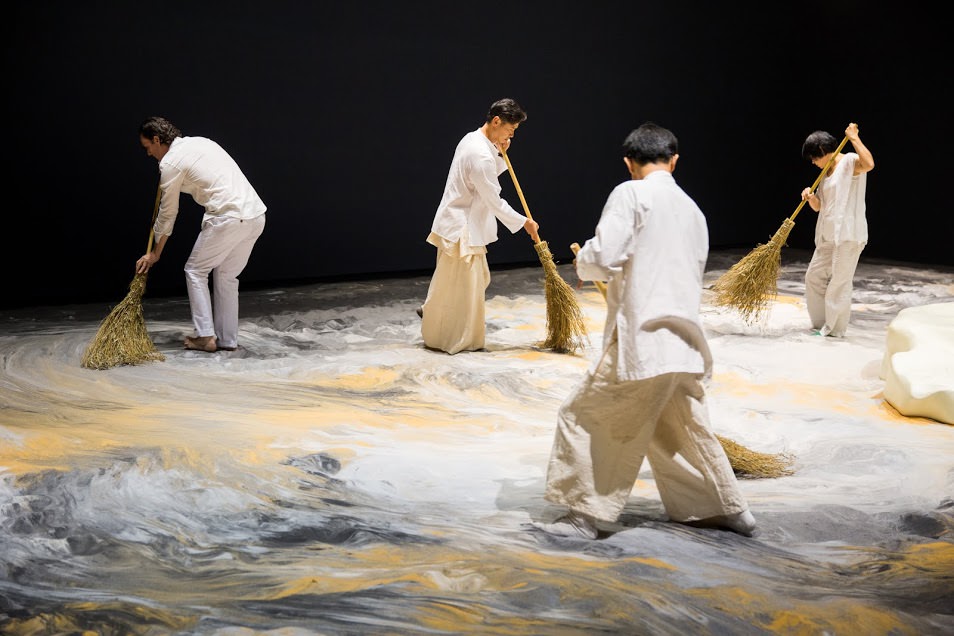
Lee Mingwei, Guernica in Sand, 2006/2015, photo from Taipei Fine Arts Museum , courtesy of JUT Museum Pre- Opening Office, Taipei.
Cockatoo Island: Embassy of the Real
Originally a convict settlement site and later one of Australia’s largest shipyards, Cockatoo Island now plays host to cultural events and film shoots. However, the remnants of the island’s history—from the massive industrial warehouses with rusting machinery to the convict quarters and stone guard-stations—serve as a constant reminder of Cockatoo’s varied history. The Embassy of the Real explores the tensions between physical and virtual reality combining video screenings from Korakrit Arunanondchai, sound installations by Cevdet Erek, performance art by Alexis Teplin, as well as the more traditional mediums of painting and sculpture by artists such as Maaike Schoorel, Camille Henrot, Bharti Kher, and Emma McNally.
Visitor’s are immediately immersed inside Lee Bul’s colossal installation Labrynth (2015), which spans the entirety of one of the warehouses within the industrial precinct of the island. The work includes large-scale tarps that fold and unravel along the ground, while blimps and hot air balloons, constructed of metallic silver and plastics, loom overhead. The physicality of Bul’s work appears front and center, yet it also subtly foreshadows the ensuing artworks on the island by combining modern materials and electronic light elements to explore the potential of technology. We eventually made our way through the warehouses contrasting the rusting industrial machinery with contemporary art installations to William Forsythe’s installation Nowhere and everywhere at the same time (2015). As a world-renowned choreographer, Forsythe’s art pieces are a conceptual dance of sorts, combining the physics of motion and momentum with the organic, instinctual movements of the human body. For this work, Forsythe sets in motion hundreds of swinging pendulums along a wide corridor, inviting visitors to walk through, modifying their own tempo and direction in order to avoid setting any of the pendulum’s out of sync.
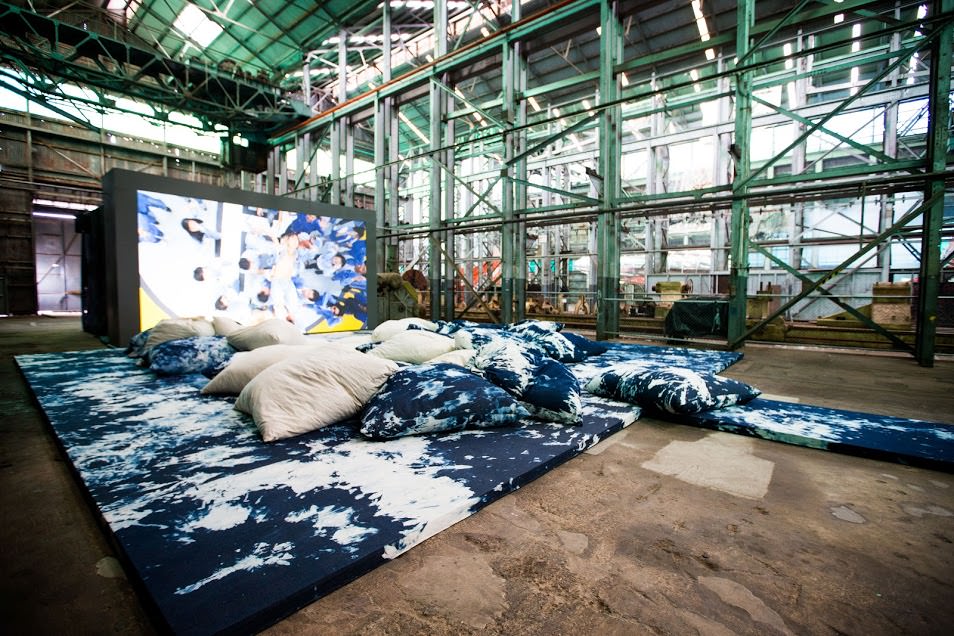
Courtesy of the Noa Eshkol Foundation for Movement Notation, Holon and Neugerriemschneider Gallery, Berlin
Museum of Contemporary Art, Australia: Embassy of Translation
The Embassy of Translation unites works that embody historical positions, artifacts, and concepts with contemporary methods of production. Works such as Noa Eshkol’s wall hangings incorporate her background in choreography and textiles, and include found materials such as uncut fabrics, kaffiyehs, and uniform remnants. Eshkol’s dancers aided in stitching the wall hangings together ultimately combining the forms of dance and visual arts. Sydney-based artist Daniel Boyd’s paintings explore the romanticized notions of colonization and the subjectivity of historical records. His work underpins the site’s core purpose of providing a space to produce a dialogue about how history and mythology inform our present moment. On the second floor, Adam Linder performed his Some Proximity (2014). Linder’s practice explores theater-oriented dance and “Choreographic Services,” which can be hired by the hour.
Art Gallery of New South Wales: Embassy of Spirits
The Embassy of Spirits includes works that highlight personal and religious ritual in order to explore the relationships between the spiritual and philosophical. Johanna Calle explores the issues of gender, politics, and social power structures that impact daily life in her native Columbia. On view at the biennale, Lluvias (2013) and Serman (2014) explore linguistics as a form of expression equivalent to art in that it is always adapting.
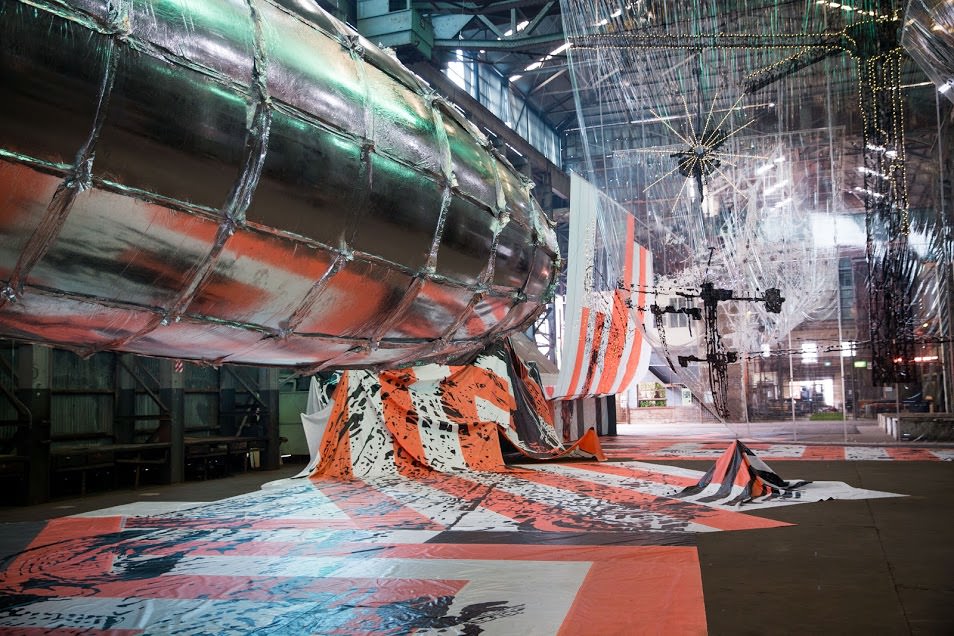
Lee Bul, Willing To Be Vulnerable, 2015–16, photo by Ben Symons, courtesy of the artist.
Taro Shinoda’s conceptual piece Abstraction of Confusion (2016) embodies karesansui, or traditional Japanese garden design, zen ideology, and the writings of Daisetsu Teitaro Suzuki. To experience Shinoda’s work, visitors remove their shoes and enter onto a platform covered in tatami mats to observe the minimalistic room covered in white and cream pigmented cracking clay. The act of viewing the piece is ritualistic in itself; by entering the observation space, viewers enter into a tacit agreement of contemplative simplicity that the piece evokes.
Artspace, Sydney: Embassy of Non-Participation
Like Cockatoo Island, Artspace has a storied past. The former gunnery and artists’ squat is now one of Australia’s preeminent alternative interdisciplinary spaces, and host to the biennale’s Embassy of Non-Participation. The artist team Karen Mirza and Brad Butler explore the theme through acts of resistance and non-participation as alternate ways to engage with politics and art. Along with their silkscreens and video installations, the artists created an ouroboros (a snake eating it’s tail) wallpaper design inscribed with the words “withdrawal,” “boycott,” and “non-participation,” to highlight the relationship of one’s role in the cycle of social participation.
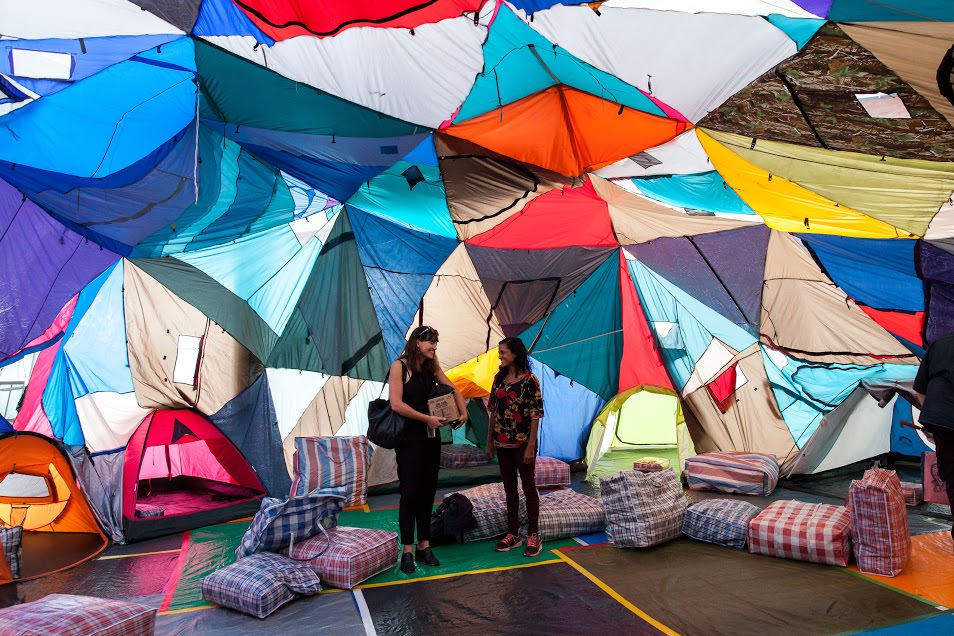
Lee Mingwei
Mortuary Station: Embassy of Transition
The Mortuary Station served as a station for the funeral train service that ran from Sydney to the Necropolis of Rookwood Cemetery from 1867 until 1948, and now serves as the site for the Embassy of Transition. At this location, Marco Chiandetti and Charwei Tsai showcase their works that engage the cycles of life, death, and rebirth. Chiandetti cast parts of his body in bird seeds, which are set in a cage with miner birds. Throughout the course of the biennale, the birds will slowly consume the sculptures exemplifying the cycles of decomposition and renewal. Tsai’s coiled incense sculptures suspend from the ceiling and slowly burn, emitting coils of smoke as the sculptures decompose. A Tibetan mantra recited for purification is inscribed on the coils that create the sculptures. Of her art, Tsai said, “Working with the ephemeral and impermanence has always been a big part of my work…I think of it as a space for the contemplation of death—and not as something morbid, but as an appreciation of life.”
Carriageworks: Embassy of Disappearance
At the Embassy of Disappearance, themes like absence, memory, and economic, political, and environmental change serve as a backdrop to the multiple artists on display. Yao Jui-Chung’s photographic documentation beautifully captures Taiwan’s complex political and historical past, while Chen Chieh-jen’s video work address the contemporary political issues of Taiwan. FX Harsono’s Raining Bed (2013) serves as a contemplative sculpture of water raining down on a message arranged in stone blocks, and focuses on the historical influence on cultural identity.
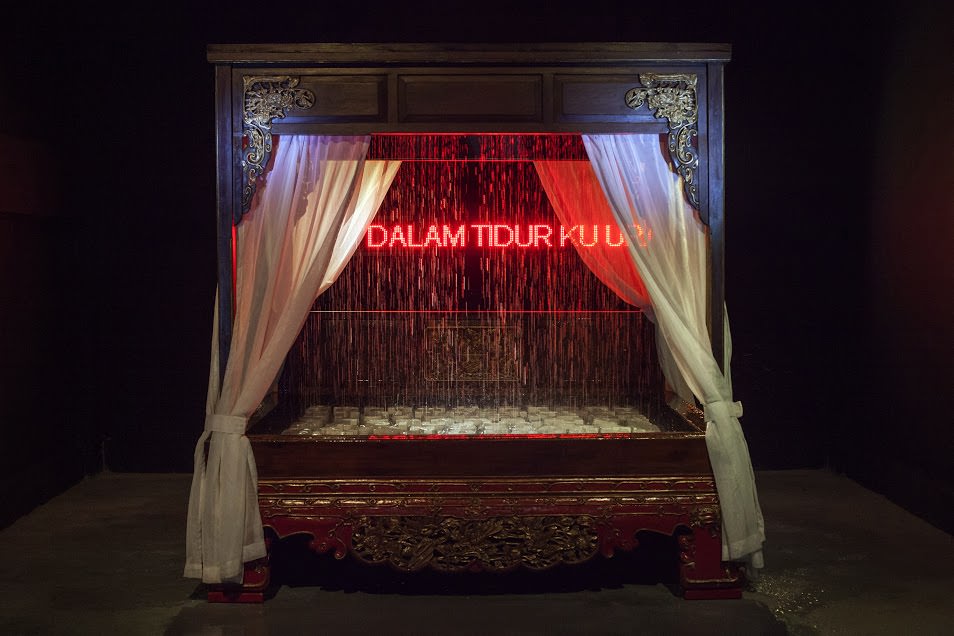
Guernica in Sand
2006/2015
There are also participatory works on display such as curatorial collective Don’t Follow The Wind’s virtual reality head pieces that take viewers on a virtual experience about the nuclear crisis at Fukushima and Lee Mingwei’s Guernica in Sand (2016). Mingwei’s works unite artist and audience through his large-scale sand works by inviting audiences to walk over the work during it’s final stages of completion. “You can always see the tension between the person creating by walking and the artist finishing the work… It’s about impermanence and the idea of a cyclical gesture,” said Mingwei. The reference of Picasso’s Guernica adds another dimension to the themes of memory, political, and social change of this embassy as the original work was a tribute to the atrocities suffered by the town of Guernica during the Spanish Civil War.
Embassy of Stanislaw Lem
The Embassy of Stanislaw Lem is a mobile book stall that will appear at various sites throughout the duration of the biennale. Heman Chong gathers copies of Polish second-hand science-fiction books from Polish author Stanislaw Lem, that are available for purchase.
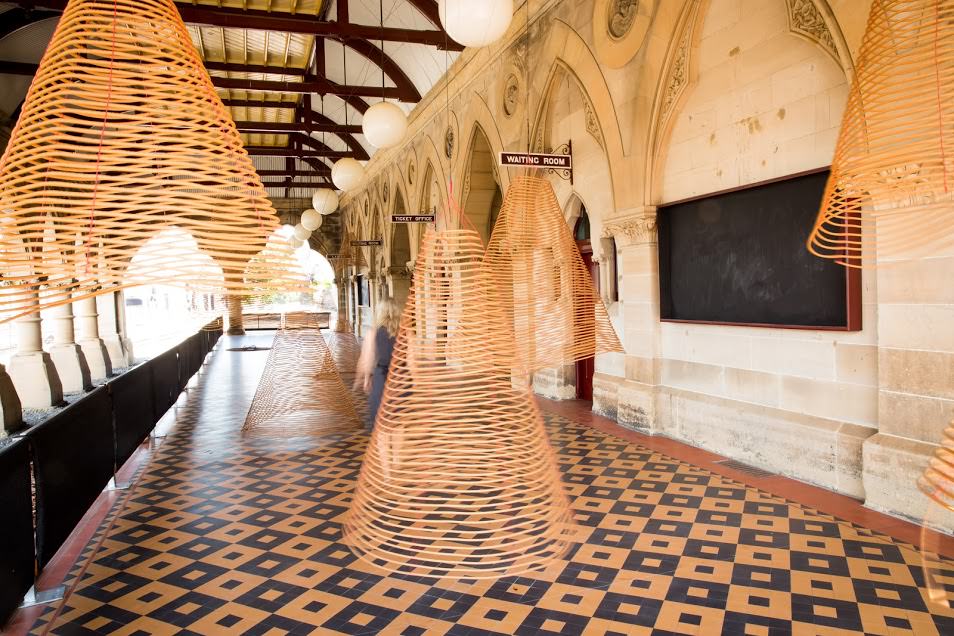
Courtesy of JUT Museum Pre- Opening Office, Taipei
Photo by Taipei Fine Arts Museum
In-between Spaces
Installations here signify the in-between spaces where the virtual and physical overlap; the works are spread throughout Sydney, although they primarily appear in the Redfern and Chippendale neighborhoods. Art will appear in alleyways, on walls, and in the cracks between buildings highlighting the displacement and occupation of spaces and land. Artists showing in these spaces include Daniel Boyd, Keg de Souza, Richard Bell, Evan Roth, Mette Edvardsen, Agatha Gothe-Snape, Bo Christian Larsson, Archie Moore, Dane Mitchell, Oscar Murillo, and the Brown Council.
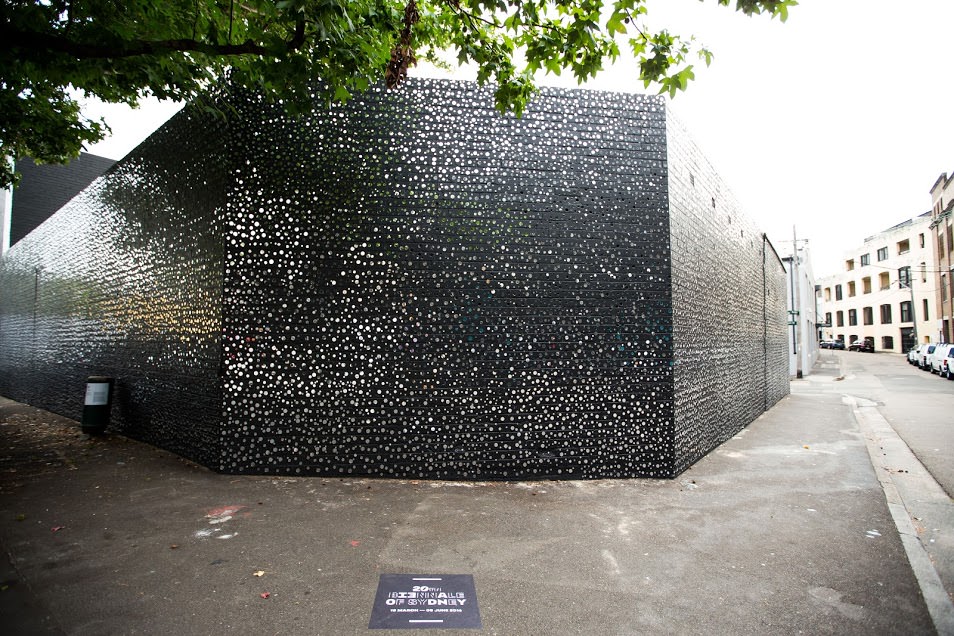
Korakrit Arunanondchai
The 20th Beinnale of Sydney is on view through June 5.




